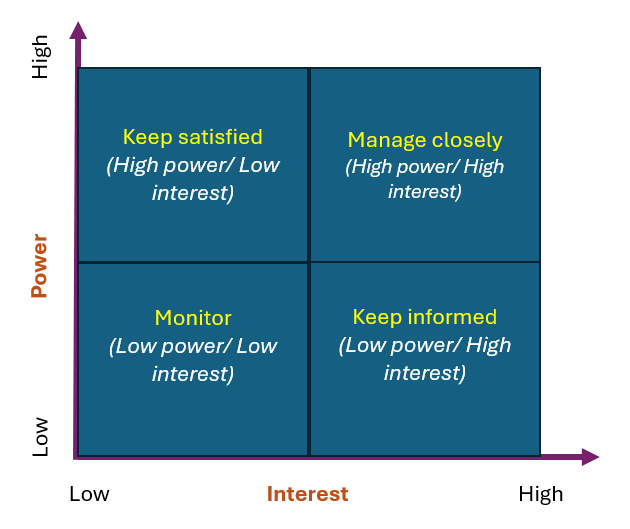The Power-Interest grid: a tool for stakeholder identification and management

In any project that an organization aims to undertake, the correct identification of stakeholders, their positions and their needs and expectations, is essential for success.
A useful tool used in project management, but that can be adapted to other domains, is the Power-Interest Grid. This tool helps project managers identify and prioritize stakeholders based on their level of power and interest in the project. The Power-Interest Grid can help ensure that you are engaging with the right people in the right way.
What is the Power-Interest grid?
The Power-Interest grid is a visual representation used to categorize stakeholders based on two key dimensions:
1. Power. The level of influence a stakeholder has over the project and its outcomes.
2. Interest. The degree to which a stakeholder is concerned about the project’s progress and results. By plotting stakeholders on this grid, project managers can develop tailored strategies for engagement and communication.
The grid is typically divided into four quadrants, each representing a different combination of power and interest levels.

1. High Power, High Interest (Manage Closely). Stakeholders in this quadrant are key players. They have significant influence and a high level of interest in the project. These stakeholders need to be managed closely and kept informed regularly. Their support is crucial for the project’s success.
2. High Power, Low Interest (Keep Satisfied). These stakeholders have a lot of influence but may not be highly interested in the day-to-day details of the project. It’s important to keep them satisfied to ensure they remain supportive. Regular updates and involving them in major decisions can help maintain their satisfaction.
3. Low Power, High Interest (Keep Informed). Stakeholders with high interest but low power need to be kept informed about the project’s progress. While they may not have the ability to influence outcomes directly, their interest means they can be valuable advocates for the project. Keeping them engaged can provide additional support and insights.
4. Low Power, Low Interest (Monitor). These stakeholders have minimal influence and interest. While they do not require intensive management, it’s still important to monitor them to ensure their needs and concerns are addressed if they arise.
How to Create a Power-Interest grid
Creating a Power-Interest Grid involves several steps:
1. Identify stakeholders: List all individuals, groups, or organizations that have an interest in the project. This can include team members, clients, suppliers, regulatory bodies, or the general public.
2. Assess power and interest: Evaluate each stakeholder’s level of power and interest. Consider factors such as their authority, impact on the project, and how much they care about its outcomes.
3. Plot stakeholders: Place each stakeholder on the grid according to their assessed levels of power and interest. This visual representation helps clarify where to focus your engagement efforts.
4. Develop engagement strategies: Based on the positioning of stakeholders on the grid, create tailored strategies for communication and engagement. Ensure that high-power, high-interest stakeholders are closely managed, while others are kept appropriately informed or satisfied.
Benefits of using the Power-Interest grid
Using the Power-Interest grid offers several benefits:
• Prioritization. Helps prioritize stakeholders and allocate resources effectively.
• Targeted communication. Enables more focused and efficient communication strategies.
• Risk management. Identifies potential risks by highlighting stakeholders who could negatively impact the project.
• Enhanced support. Build stronger relationships with key stakeholders, ensuring their support and involvement.
Conclusion
The Power-Interest grid is a great tool for project managers looking to navigate the complex landscape of stakeholder management. By categorizing stakeholders based on their power and interest, project managers can develop targeted engagement strategies that maximize support and minimize resistance.
All popular management system standards published by ISO require the organization to determine interested parties (stakeholders) and their relevant requirements. The power-interest grid can be used outside of the realm of project management for stakeholder identification.
If you want to know more about project management and the guidelines of the interational standard ISO 21502 you can check out our online course on the subject. All our available courses are listed here.

